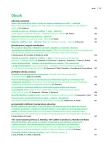Importance of lymphangiogenesis and ultrastructure of lymphatic capillaries in metastasis of malignant melanoma
Authors:
Eva Rovenská
Authors‘ workplace:
Klinika chirurgickej onkológie Slovenskej zdravotníckej univerzity a Národného onkologického ústavu, Bratislava, Slovenská republika, prednosta prof. MUDr. Juraj Pechan, CSc.
Published in:
Vnitř Lék 2014; 60(7-8): 582-585
Category:
Reviews
Overview
Lymphangiogenesis – proliferation of lymphatic capillaries – in melanoma and in its vicinity plays an important role in metastatic process of malign melanoma cells in organism. Melanoma produces epidermal growth factor EGF which induces vascular endothelial growth factor VEGF-C and thereby starts lymphangiogenesis. It is very probable that malignant melanoma cells enter lymphatic capillaries also through specialized inter-endothelial junctions (endothelial microvalves, primary valves) situated in their walls. After entry of malign cells into lymphatic capillaries, these cells travel in lymph to the sentinel lymph node. Malign cells metastasize through lymphatic vessels probably also directly into distal regional lymphatic nodes. Metastasizing through blood vessels is suggestible also in early stage melanoma.
Key words:
lymphangiogenesis – malignant melanoma – sentinel lymph node
Sources
1. Alitalo A, Detmar M. Interaction of tummor cells and lymphatic vessels in cancer progression. Oncogene 2012; 31(42): 4499–4508.
2. Neoral Č, Bohanes T et al. Biopsie sentinelové uzliny. Galén: Praha 2012. ISBN 9788072628827.
3. Olszewski WL. Interrelationships within the lymphatic system. In: Olszewski WL (ed.) Lymph Stasis: Pathophysiology, Diagnosis, and Treatment. CRC Press: Bocca Raton 1991: 5–12. ISBN 0–8493–6499-X.
4. Rovenská E, Rovenská E, Štvrtina S. Štruktúra a funkcia lymfatických ciev. In: Štvrtinová V (ed.) Choroby ciev. SAP: Bratislava 2008: 821–829. ISBN 978–80–8095–025–5.
5. Casley-Smith JR. The fine structure and functioning of tissue channels and lymphatics. Lymphology 1980; 13(4): 177–183.
6. Főldi M, Staubesand J Die Lymphgefässe. In: Benninghoff A (ed) et a. Makroskopische und mikroskopische Anatomie des Menschen. Urban & Schwarzenberg: München-Wien-Baltimore 1985: 39–44.
7. Witte MH, Ohkuma M, Anrade M et al. Nature´s historic gap: the 20th century of lymphology. Lymphology 2005; 38(4): 157–158.
8. Pullinger BD, Florey HW. Proliferation of lymphatics in inflammation. J Pathol 1937; 45(1): 157–170.
9. Pullinger BD, Florey HW. Some observations on the structure and functions of lymphatics: their behaviour in local oedema. Brit J Pathol 1935; 16(1): 49–61.
10. Leak LV, Burke JF. Fine structure of the lymphatic capillary and the adjoining connective tissue area. Am J Anat 1966; 118(3): 785–810.
11. Das S, Skobe M. Lymphatic vessel activation in cancer. Ann NY Acad Sci 2008; 1131: 235–241.
12. Tammela T, Alitalo K. Lymphangiogenesis: Molecular mechanisms and future promise. Cell 2010; 140(4): 460–476.
13. Cianfarani F, Mastroeni S, Odorisio T et al. Expression of vascular endothelial growth factor-C in primary cutaneous melanoma predicts sentinel lymph node positivity. J Cutan Pathol 2012; 39(9): 826–834.
14. Bracher A, Cardona AS, Tauber S et al. Epidermal growth factor facilitates melanoma lymph node metastasis by influencing tumor lymphangiogenesis. J Invest Dermatol 2013; 133(1): 230–238.
15. Dadras SS. An unexpected role for EGF in lymphangiogenesis-mediated melanoma metastasis to sentinel lymph nodes. J Invest Dermatol 2013; 133(1): 14–16.
16. Morton DL. Overview and update of the phase III Multicenter Selective Lymphadenectomy Trials (MSLT-I and MSLT-II) in melanoma. Clin Exp Metastasis 2012; 29(7): 699–706.
17. Grotz TE, Mansfield AS, Jakub JW et al. Regional lymphatic immunity in melanoma. Melanoma Res 2012; 22(1): 9–18.
18. Dadras SS, Lange-Asschenfeldt B, Velasco P et al. Tumor lymphangiogenesis predicts melanoma metastasis to sentinel lymph nodes. Mod Pathol 2005; 18(9): 1232–1242.
19. Moehrle M, Schnippert W, Rassner G et al. Micrometastasis of a sentinel lymph node in cutaneous melanoma is a significant prognostic factor for disease-free survival, distant-metastasis-free survival, and overall survival. Dermatol Surg 2004; 30(10): 1319–1328.
20. Baldwin BT, Cherpelis BS, Sondak V et al. Sentinel lymph node biopsy in melanoma: facts and controversies. Clin Dermatol 2010; 28(3): 319–323.
21. Ikomi F, Hunt J, Hanna G et al. Interstitial fluid, plasma protein, colloid and leukocyte uptake into initial lymphatics. J Appl Physiol 1996; 81(5): 2060–2067.
22. Trzewick J et al. Evidence for a second valve system in lymphatics: endothelial microvalves. FASEB J 2001; 15(10): 1711–1717.
23. Schmid-Schönbein GW. The second valve system in lymphatics. Lymphat Res Biol 2003; 1(1): 25–29.
24. Sjöberg T, Steen S. Contractile properties of lymphatics from human lower leg. Lymphology 1991; 24(1): 16–21.
25. Krajsová I. Melanom. Maxdorf: Praha 2006. ISBN 80–7345–096–8.
26. Garbe C, Peris K, Hauschild A et al. Diagnosis and treatment of melanoma. European consensus-based interdisciplinary guideline-update 2012. Eur J Cancer 2012; 48(15): 2375–2390.
27. Wong SL, Balch CM, Hurley P et al. Sentinel lymph node biopsy for melanoma: American society of clinical oncology and society of surgical oncology joint clinical practice guideline. J Clin Oncol 2012; 30(23): 2912–2918.
Labels
Diabetology Endocrinology Internal medicineArticle was published in
Internal Medicine

2014 Issue 7-8
Most read in this issue
- Endoscopic classification of colon and rectal neoplasias
- Acute pancreatitis – Validation of Revised Atlanta Classification on 159 patients and prognostic factors
- Crohn's Disease Surgery
- Management of patients with dyspepsia
